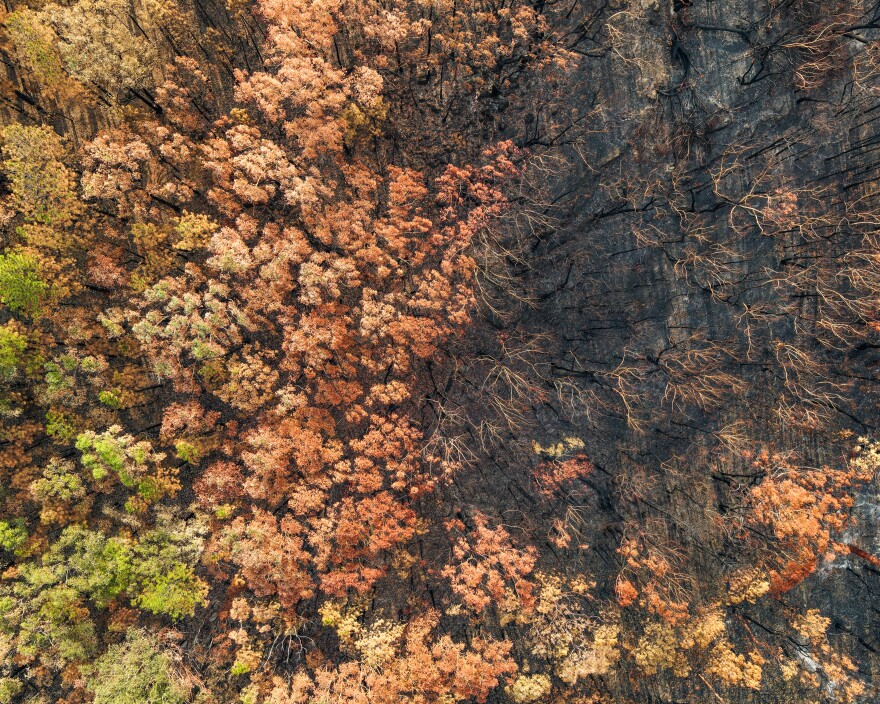As a child, I believed I was in great peril of catching fire. Growing up in the era of “Stop, drop, and roll,” I knew that if I ever found my clothes on fire, I was to stop whatever I was doing, drop to the ground, and roll, roll, roll until that fire was smothered. I always wondered, though: after the flames were gone, what then? What happens after the fire is extinguished?
That same thought echoed through time when I took an autumn hike to Passage Creek Falls in Paradise Valley. Fifteen years after the Wicked Creek Fire tore through this canyon, the remnants of fireweed, now dormant and dry for the season, still proliferated in the area. Young lodgepole pines dotted the landscape on each side of the trail, stepping high up the hillsides. I saw charred dead trees, or snags, still standing tall, now evidencing their repurposed role to provide food and shelter for insects and birds alike.
What exactly happened here after the fire died out? Is it fair to say that a landscape is “destroyed” by a fire? How does the now-scarred ecosystem change and begin to repropagate after it’s been ravaged by intense heat? And when does it start? How does fire, a regular and often naturally occurring event, benefit our environment?
Despite the harsh and stark appearance, all is not lost after a wildfire. In fact, there is much to be found when you look about.
Surviving trees and shrubs are reduced in number now and no longer compete for nutrients, light, and water. They may even show accelerated and prolific growth, as they benefit from the minerals left behind in the soil. Some plant life may become healthier as fire rids them of infesting parasites, like the dwarf mistletoe that grows high on lodgepole pines.
The lodgepole pines also benefit from fire in other ways. Their serotinous cones seal in their seeds with an external resin that only melts at a temperature of at least 113°F (45°C). As fire consumes the litter on the forest floor and creates an open canopy allowing in plenty of sunlight, it also melts the resin. This adaptation ensures the seeds only disperse once a fire creates conditions favorable to new growth.
Below ground, root systems of many grasses, ferns, and forbs, like horsetail and fireweed, typically remain undamaged. The rebound of these plant communities can begin as soon as they receive moisture, which may be within days at some sites.
Similarly, the connecting underground root networks of quaking aspens can survive very hot fires. Although their trunks above ground may be scorched, fire stimulates the roots to sprout new suckers, and the now-enriched soil makes it perfectly suited to establish new seedlings.
In the trees that remain, cavity-nesting birds, like Northern Flickers, Mountain Bluebirds, and Black-capped Chickadees, scout out new habitat among the fallen logs and burned-out snags. The dead wood also provides a good food source for insects, like wood-boring beetles, and an important habitat for laying their eggs. In turn, these insect larvae offer a hearty food source to birds like Hairy Woodpeckers. Nearly synonymous with burned forests, the Black-backed Woodpecker specializes in locating charred timberlands just weeks to months after a wildfire and will live off the bounty of these insects for several years.
What happens after a wildfire may seem devastating at first, but plant communities dependent on a clean forest floor, nutrient-rich soil, and an open canopy have new opportunities to grow. The renewed habitat created by the fire teems with new life, new residents, and increased biodiversity. It’s a whole new world – one in which I can appreciate the fire, instead of being afraid of it.
Today’s Field Note was written in the Field Notes Writing Workshop at the Montana Natural History Center. This is Eden Potratz for Field Notes, brought to you by the Montana Natural History Center, providing natural history education for schools and the public throughout Montana. To find out about upcoming events and programs at the Center, call 406.327.0405, or visit our website at MontanaNaturalist.org.





